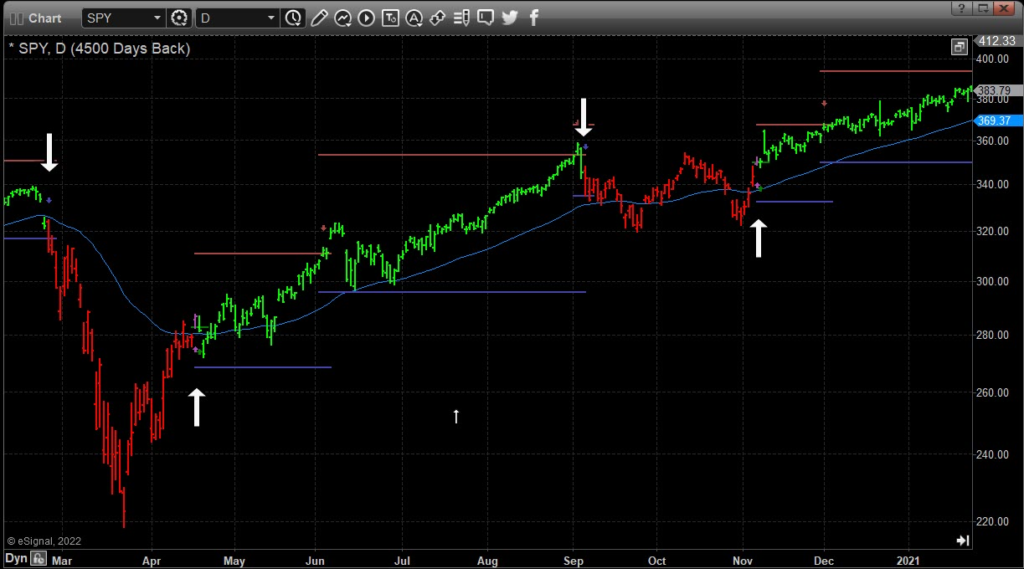
Key Takeaways:
- Focuses on trading in and out of a single asset (stock, bond, commodity, or currency).
- A simple way to take advantage of short-term price fluctuations and gain the potential for higher returns.
- Requires a higher level of expertise or access to asset revesting signals.
- It can be deployed by anyone but is more important for investors 50+ or older with a shorter investment horizon.
What is Single Asset Revesting?
The primary objective of single-asset investing is to move in and out of a single asset or a small group of closely related assets to take advantage of short-term price fluctuations. Revesters (as we call them) use technical analysis to identify trends in an asset’s price movement and implement position and risk management to protect against potential losses during market corrections and bear markets. As a result, single-asset revesters only hold assets increasing in value, thus reducing portfolio volatility while gaining above-average returns.
Single Asset Revesting can be a useful approach for investors with a high level of expertise who focus on particular assets and want to focus their efforts on maximizing returns from that one particular asset. On the other hand, multi asset revesting is another way to invest, which provides more consistent and larger returns.
Why Choose Single Asset Revesting?
While diversification is an important strategy to hedge against risk, investors who are very familiar with a set of closely related assets (such as precious metals and miners) can use single asset revesting. Doing so will help them get the best returns on their favored sector while also mitigating the potential for losses, should that sector become volatile or bearish.
What Kind of Assets Work for Single Asset Revesting?
A wide range of assets qualify for Single Asset Revesting, including indexes, sectors, individual stocks, bonds, commodities, currencies, or groups of related assets such as precious metals, which move together as a group.
For example, some proven single-asset revesting strategies and systems focus on exchange-traded funds (ETF) trades (see chart below), which provide maximum liquidity for high-net-worth individuals who do not want to deal with the headaches of scaling in and out of stock positions. ETFs are generally less volatile than individual positions, they trend more consistently, and large amounts of capital can be invested in them at any given time. With stocks, on the other hand, prices can move with large trade orders, and repetitive entering and exiting can become costly.

Single Asset Revesting can also include making purchases such as artwork, real estate, vintage cars, and so on. Generally, growing this type of investment requires in-depth knowledge of not only the asset class itself, but also the timing of when to add to the collection.
Pros and Cons of a Single Asset Revesting
It is important to carefully consider the potential risks and rewards of any investment before making a decision to buy or sell. Some potential pros of single-asset revesting include:
- Potential for higher returns: By focusing on a single asset or group of closely related assets rather than a diversified buy-and-hold portfolio an investor may be able to more effectively identify and capitalize on favorable market conditions, potentially leading to higher returns.
- Ability to take advantage of short-term price fluctuations: Single-asset revesting involves actively trading an asset in order to take advantage of short-term price movements. This can be an effective way to generate returns in a relatively short time frame.
- Simplicity: Single-asset revesting can be easier to manage compared to a more diversified portfolio, which may require more time and effort to monitor, rebalance and adjust.
- Focusing on “passion” investments: Single-asset revesting gives collectors and those who are passionate about a certain investment or sector the opportunity to benefit from their knowledge and, in the case of tangible assets, leverage market downturns to add to a collection that’s meaningful to them.
Some of the potential drawbacks to Single Asset Revesting include:
- Potential for missed opportunities: Single-asset revesting emphasizes a single asset or small group of related assets. By not following different uncorrelated assets, there is very little opportunity for growth when the revesting asset is falling, which can last weeks and even years.
- Requires a higher level of expertise: Single-asset revesting requires a higher level of knowledge and understanding of a particular asset or group of assets in order to make informed decisions about when to buy and sell. If an investor doesn’t have a strong understanding of the asset, it may be more difficult to successfully implement this strategy.
Is Single Asset Revesting Right for You?
Overall, single-asset revesting is a useful strategy for certain investors who have a high level of expertise in a particular asset class and who understand position and risk management. It can also be a powerful way to increase returns when used as part of an investor’s portfolio, as it provides diversification of investment strategies.
However, investors must carefully consider the potential risks and rewards of any investment before buying or selling. Ultimately, each individual’s financial situation. Time horizon, investment plan and objectives determine whether single-asset revesting is right for them.
Asset Revesting Signals
Single-asset revesting requires revesters to analyze trends and continuously look for asset revesting signals to manage that portion of their portfolio. This isn’t always something a revester wants to do, in which case they can look for revesting signal providers who can help make this a reality. TheTechnicalTraders.com is one provider that makes revesting signals easy by generating them for subscribed revesters.
Can Single Asset Revesting Strategies be Automated?
For the investor who is tired of the stock market rollercoaster ride in their Fidelity or Schwab type accounts, an automated asset revesting strategy seems to be the best solution. But if a revester doesn’t want to manage their positions on their own, they may want to look for a service providing autotrading within self-directed brokerage accounts, including, IRAs, trusts, and more.
Roboadvisors like Wealthfront and Betterment provide low-cost autotrading for millions of investors, but they don’t offer revesting as one of their chosen strategies. Because they focus on buy-and-hold strategies, Robo Report has shown that they have average annual returns, ranging from 2% to 5%. This is lower than some revesting autotraders, such as TheTechnicalTraders.com, which has an average annual compounded return of 15.6% since the stock market top in 2007.
Concluding Thoughts
It’s a significant change from what has been done in the past. The norm has been to invest (buy-and-hold) positions and ride out market fluctuations while revesting rotate capital into only assets rising because it does not hold positions falling in value, nor does it spread its money over many assets (diversify), which only produces status quo results. It generates higher and more reliable returns with a fraction of the portfolio volatility compared to traditional investing methods used by firms like Schwab and Fidelity or financial advisors.
Imagine if you could sell your investments as they started to top. Then, revest the money into different assets rising in value, and never have to hold falling positions again. That’s Asset Revesting
